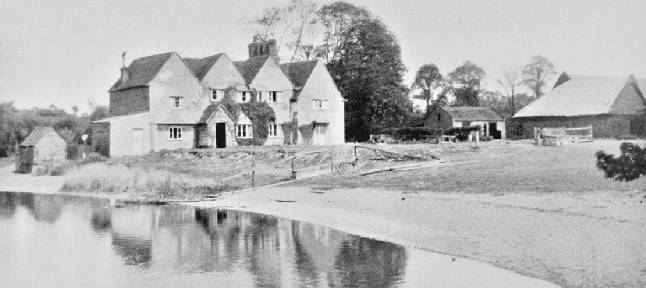Canvers or Calbourne Manor
Canvers or Calbourne Manor
The history of the manor of Canvers or Calbourne is less well documented. The manor house itself was located about a half mile SSE of the church in the area known as The Warren and was of 15th century construction. The farm house, later known as Manor Farm, was constructed around the earlier manor house and whilst it was undergoing demolition in 1938 to make way for gravel extraction, workmen discovered the original carved timbers in immaculate condition.
A fine from 1242 gives a clue as to the early ownership of the manor:-
Stephen, Prior of the Blessed Mary of Suthwerk, plantiff. Robert le Franceys, deforciant. That deforciant should warrant to plaintiff a third part of 120 acres of land, 4 acres of meadow, and 2 acres of wood, with appurtenances. in Coringham and Stanford, which Alice who was the wife of Geoffrey de Franceys, deforciants brother, whose heir he is, claimed as dower out of the free tenement of the said Geoffrey in the same towns. Deforciant acknowledged the right of plaintiff and his church; to hold to plaintiff and his successors, doing all services to the chief lords of that fee for deforciant and his heirs. Plaintiff, at the petition of Robert, gave to Alice 2 marks of silver. Alice was present and consenting, and quitclaimed from herself to planitiff and his successors and to deforciant and his heirs all her right in the said third part.
It is probable that the land referred to in this document is that which was later known as the manor of Calbourne and that it was held by Robert de Franceys in that year.
In 1342 John de Newenton held the manor comprising one messuage and 100 acres of land in free focage (tenancy) by the service of four marks yearly to Hugh FitzSymon and also 80 acres by Mary de St Paul widow of Adomare de Valence who also held the Manor of Hassingbrook. It is not recorded who held the manor before John Caborne who was in possession in 1429. John Caborne’s name is associated with the area to this day as the name Cabborns is that of the old manor and also a road and house in its vicinity.
The manor was held by Richard Walsh and Richard Pigge who sold it in 1465 to William Henisey of London, described as a grocer. In 1607 the manor was in the possession of Reginald Hallingworth who later sold it to the Featherstone family. Again the ownership in the intervening years is unknown.
In 1836 the system of Tithe payment in kind whereby farmers were obliged to pay one tenth of their produce to the Rector of the parish was abolished by the Tithe Commutation Act and replaced by a system of monetary payments. The 17th century tithe barn where the produce was stored was still in existence in 1900 at St.Margarets at the time of an extension to the churchyard. A survey of the parish was thus made in 1839 to determine the level of such monetary payments and shows Cabborns Manor and farm in the possession of John Mayes with an area of 402 Acres, 0 Roods, and 21 Perches.
